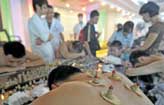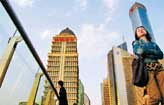Tips and Articles
A red-letter day for tourism
Updated: 2011-07-28 08:02
By Yang Jun and Qiu Bo (China Daily)
The growing popularity of "red" tourism has brought change to Zunyi, a well-known revolutionary city in Guizhou province.
Tao Zhengli, 30, was formerly a tea farmer in Meitan county, Zunyi, but now works as a tea store manager on Red Army Street, a business district established four years ago by the local government to boost "red" tourism.
Tourists from all over the country are pouring in and Tao's high-end tea is selling well, he says.
The city is best known for the Zunyi Meeting in 1935 - a significant event in the history of the Communist Party of China (CPC) - when Mao Zedong was elected to the leadership of the CPC. The site of the meeting is the city's top attraction.
After visiting the site, tourists tend to visit nearby Red Army Street, which sells local liquor, tea and other specialties.
"In 2010, more than 16 million tourists came to Zunyi," says Wang Zhili, deputy manager of Zunyi Red Tourism Company.
Wang's company, established in 2007, manages most of the city's tourist destinations, including the site of the Zunyi Meeting and the business district.
The company built Red Army Street at a cost of 219 million yuan ($34 million). Though the initial investment has not yet been covered by rentals in the past four years, it is still a sound investment, Wang says.
He adds the street has 176 tenants, whose stores cover 17,000 square meters.
"The total annual rental is around 15 million yuan."
Liu Qiu, a 38-year-old tenant, says business is flourishing at his 20-sq-m store, selling sponge cake and beef jerky, earning a net pro-fit of approximately 6,000 yuan ($931) a month.
Liquor-store manager Yan Xiaorong says tourists are keen to sample the local spirits and she makes about 40,000 yuan a month.
Naturally, the hotel industry has been boosted by red tourism too and Wang says the occupancy rate is above 80 percent and up to 90 percent for the higher-class hotels.
By the end of 2010, the number of tourism firms has increased to 400. Meanwhile the provincial government is promoting "red" tourism, by enhancing cooperation with other revolutionary cities, says Fu Yingchun, head of the provincial tourism bureau.
"For instance, a new route will be launched, including the cities of Guiyang and Zunyi in Guizhou, Chongqing, and Guang'an in Sichuan."
"We hold forums every year, inviting tourism experts from other red cities like Yan'an in Shaanxi province and Jinggangshan in Jiangxi province," says Lan Bo, an official at Zunyi's tourism bureau.
"We exchange ideas and share our experiences."
From 2005 to 2010, the central government invested more than 86 million yuan ($13 million) in Guizhou's tourism industry.
Lan says the province also appeals to overseas tourists.
"We are expecting more foreigners to come, but the condition of the roads is a limiting factor," adds Wang, of Zunyi Red Tourism Company.
As a result, the roads between Guizhou and neighboring provinces are expected to significantly improve in the next three years.
Additionally, a high-speed railway will be built in the next few years.
From 2005-2010, the central government designated landmarks with historical links to the development of the CPC in order to boost the economy of revolutionary regions.
The increased tourism has provided job opportunities for approximately 2 million people and has indirectly benefited 10 million others.
China Daily

Specials

Turning up the heat
Traditional Chinese medicine using moxa, or mugwort herb, is once again becoming fashionable

Ciao, Yao
Yao Ming announced his retirement from basketball, staging an emotional end to a glorious career.

Financial sector short of talent
Lack of skilled professionals in Shanghai inhibiting the city's development as a financial hub